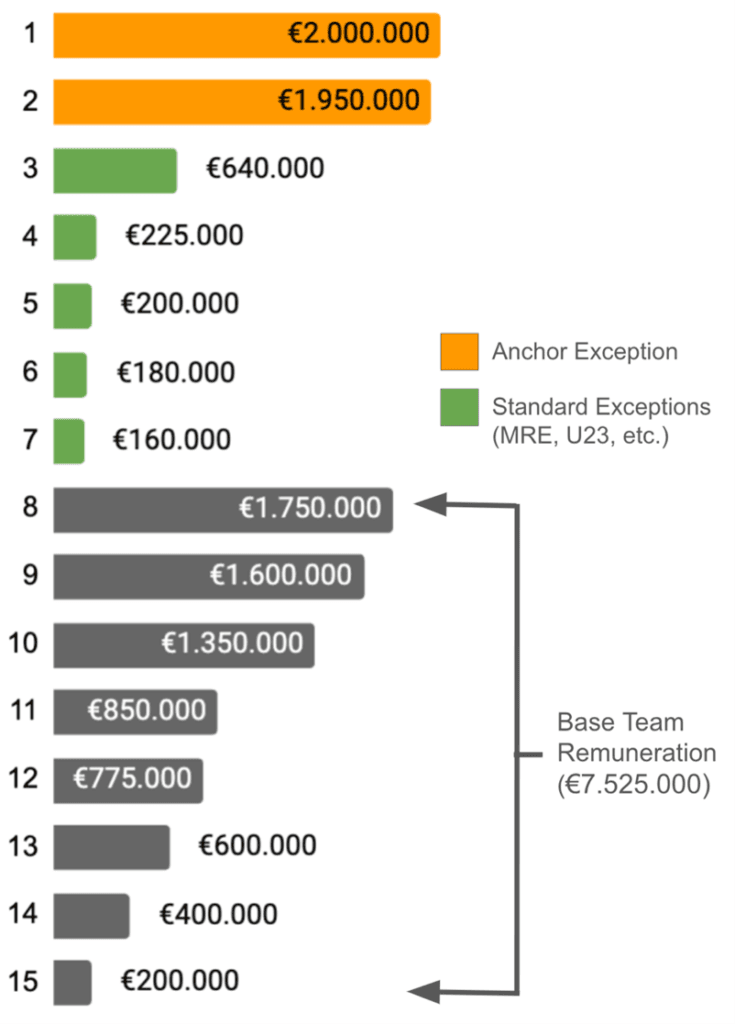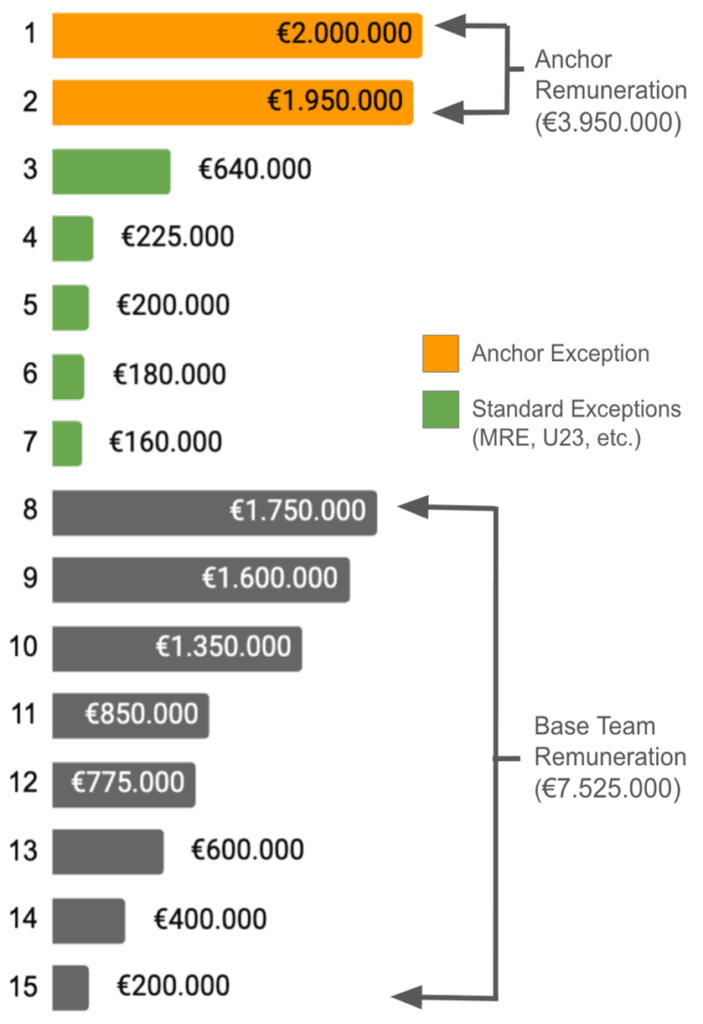I. OVERVIEW
The Competitive Balance Standards (CBS) are the next step in the evolution of the existing EuroLeague Financial Stability and Fair Play Regulations. The new set of financial regulations is designed to increase competitive balance, control spending and promote sustainable business among EuroLeague clubs. In essence, under the CBS rules, clubs may face financial penalties, called the Competitive Balance Compensation (CBC), for either insufficient or excessive spending on their players.
II. PROCESS
Each season, the league office will calculate the Average Licensed Clubs Defined Revenues or ALCDR, which serves as a representation of average revenues that EuroLeague licensed clubs earn during a specific time-frame. For the 2025-26 and 2026-27 seasons, the ALCDR will be calculated using a three-season average, but starting from the 2027-28 season, the ALCDR calculation will shift to a two-season average. ALDCR consists of all forms of basketball-related income, including:
- game day revenues (ticket sales, food & beverage sales, merchandise sales, advertisement, parking, etc.)
- commercial revenues (corporate partnerships, league’s economic distribution, merchandise sales, licensing, non-game programing, etc.)
- non-operating revenues (youth program revenues, player transfers, public sector revenues, etc.)
III. REMUNERATION LEVELS
The spending levels or the Remuneration levels (in net amounts) are calculated as a percentage of the ALDCR. CBS rules create three Remuneration levels, which clubs must observe in order to comply with the rules:
- Low Remuneration Level or LRL
- Base Remuneration Level or BRL
- High Remuneration Level or HRL
The LRL is a lower spending level. Basically, each club must spend on their team above this level by the end of the transfer market to comply with the rules.
The BRL and HRL are the upper spending levels. Clubs must stay below these two levels or use Exceptions to avoid the CBC payment (more information in section IV).
Remuneration levels for clubs are determined by the following % of the Average Licensed Clubs Defined Revenues (ALCDR):
- LRL = 30% of ALDCR (32% in season 2027-28)
- Reduced rate for Wildcard and EuroCup clubs
- BRL = 40% of ALDCR
- HRL = 60% (not in force until season 2027-28)
To ensure stability, the BRL minimum threshold is €8M net per club for the first three seasons. The HRL goes into force in the season 2027-28, for which the minimum threshold is set at €12M net. In the same season the LRL will increase from 30% to 32%. Wildcard and EuroCup winner clubs will have a reduced rate LRL (more information in Section VI).
Each season, the Remuneration levels amounts for the next season will be announced by March 1.
Season 2025-26 and 2026-27

Season 2027-28

IV. KEY CONCEPTS AND RULES
Rule #1: For Remuneration Level purposes, players’ remuneration (in net) includes:
- Base salary
- Image rights payment (if any)
- Third party payments (if any)
- Agents fees (if paid by the club)
- Transfer fees (if any)
- Individual bonuses (if any)
- Total value of fringe benefits (housing, vehicle, etc.,.)
Collectively negotiated team bonuses based on team performance/achievements will not be considered for Remuneration Level purposes.
Rule #2: “Total Team Renumeration” must be greater than the LRL
To determine whether or not a club is above the Low Remuneration Level or LRL, the key concept is Total Team Remuneration, which is each club’s net total spend on all their registered players during a single season. This is pretty simple – according to the rules, by the end of the transfer market each club must spend on their players more than the LRL.
In case a club fails to reach the LRL, it will be required to pay the difference, which will be equally distributed among its registered players with professional contract. Additionally, clubs must spend a minimum of 80% of the LRL already by the Regular Season Round 1, or pay the difference to their players.
Total Team Renumeration > LRL (30% of ALDCR)
Example:
This club has 15 registered players, with their net remuneration ranging from €150.000 to €1.150.000. The LRL for the season is set at €6M.
The Total Team Remuneration is the net remuneration sum of all 15 players on the roster (€5.920.000). To comply with the rules, the club must ensure that the number stays above the LRL by the end of the transfer period. However, if the Total Team Remuneration is less than the LRL, then the club is required to pay the difference to its players.
 In this example, the LRL for the season is set at €6.000.000, but by the end of transfer widow the club only spent €5.920.000 in Total Team Remuneration. Therefore, the club would owe €80.000, which would be equally distributed among all registered players with professional contract.
In this example, the LRL for the season is set at €6.000.000, but by the end of transfer widow the club only spent €5.920.000 in Total Team Remuneration. Therefore, the club would owe €80.000, which would be equally distributed among all registered players with professional contract.
Rule #3: Exceptions
Under the CBS rules, not all players’ remuneration is treated equally. Clubs may assign certain players under one of the Exceptions, which means that their remuneration will not count against the upper spending levels (BRL or HRL). In other words, to spend beyond the upper levels without facing financial penalties, clubs can add players who are assigned under the Exceptions.
Types of Exceptions:
- ANCHOR PLAYER EXCEPTION (APE):
- Renumeration of maximum 2 designated players per team (generally the two highest-paid players).
- Anchor Player Exceptions do not count against the BRL. However, they will count against the HRL, starting in season 2027-28.
- STANDARD EXCEPTIONS:
- Mid-Range Exception (MRE):
> Full MRE: 1 designated player per team with a mid-range remuneration (6-8% of the BRL) can be used by clubs who did not exceed BRL or HRL in the previous season.
> Small MRE: 1 designated player per team, with a smaller mid-range remuneration (4-5% of the BRL) can be used by clubs who did exceed BRL or HRL in the previous season.
- Under-23 Player Exception (U23E): renumeration of all players on the team under the age of 23.
- Extended Tenure Player Exception (ETE): 25% of renumeration of all players on the team with 3+ seasons with the club (not needed to be consecutive).
- Long-Term Unavailability Exception (UE): in case a player is sidelined (exceeding two months) due to a long-term injury, doping suspension or disciplinary sanction, the club may apply to exclude replaced player’s prorated remuneration during the time of unavailable player’s absence.
Rule #4: “Base Team Remuneration” must be less than the Base Remuneration Level (BRL)
Understanding the calculations regarding the upper remuneration levels is a bit more complicated. To calculate whether or not a club is over the BRL, the key concept is Base Team Remuneration, which is the net remuneration of all clubs’ registered players who do not qualify under any of the Exceptions (also called non-Exception players). In order for clubs to avoid paying the CBC, their Base Team Remuneration must remain below the BRL.
Base Team Remuneration < BRL (40% of ALDCR)
Example:
This club has 15 registered players. 7 players are designated under various Exceptions. The BRL for the season is set at €8M.
 Two highest-paid players are designated under the Anchor Player Exception (orange), while five players are designated under Standard Exceptions (green).
Two highest-paid players are designated under the Anchor Player Exception (orange), while five players are designated under Standard Exceptions (green).
In grey, the club’s Base Team Renumeration is the sum of eight non-Exception players, totaling €7.525.000, which is correctly below the BRL (€8M).
If club’s Base Team Renumeration would exceed the BRL at any point during the season, the club would be subject to CBC payment, according to the size of the overage (more information in Section V). Anchor Player Exceptions and Standard Exceptions do not apply for the BRL calculations, as they can be used to exceed the BRL.
Rule #5: “Base Team Renumeration” PLUS “Anchor Renumeration” must be less than the High Remuneration Level (HRL)
The HRL rule is not in effect before the season 2027-28, however, it is beneficial to start understanding its rules as well. To calculate whether or not a club is over the HRL, the key concept is Anchor Renumeration, which is the net remuneration paid to club’s one or two highest-paid players, which are designated players under the terms of the Anchor Player Exception. In order for clubs to avoid paying the CBC, Base Team Remuneration PLUS Anchor Remuneration cannot exceed the HRL. Only the Standard Exceptions can be used to exceed the HRL.
Base Team Remuneration + Anchor Remuneration < HRL (60% of ALDCR)
Example:
To demonstrate how this works we are using the same example as before. Club has 15 registered players. 7 players are designated under various Exceptions. The BRL for the season is set at €8M, while the HRL is set at €12M.
 Two highest-paid players are designated under the Anchor Player Exception (orange) and five players are designated under Standard Exceptions (green).
Two highest-paid players are designated under the Anchor Player Exception (orange) and five players are designated under Standard Exceptions (green).
The Anchor Renumeration is the renumeration paid to both Anchor Players, in this case €3.950.000.
The Base Team Renumeration (in grey) is the sum of eight non-Exception players, totaling €7.525.000, which is correctly below the BRL (€8M).
In this example, the club’s Anchor Renumeration PLUS Base Team Renumeration is equal to €11.475.000, which is correctly below the HRL (€12M).
If Anchor Renumeration PLUS Base Team Renumeration would exceed the HRL at any point during the season, the club would be subject to CBC payment, according to the size of the overage (more information in Section V). Standard Exceptions do not apply for the HRL calculations, as they can be used to exceed the HRL.
Rule #6: Clubs can spend above the upper remuneration levels, but with consequences
Under the CBS rules, players’ individual or team remuneration is not limited or “hard capped”, but it will take clubs’ calculated approach to assemble a competitive team without paying the CBC. In order to achieve this, clubs will have to take into account the following scenarios:
- The remuneration of non-Exception players is not limited, but if the Base Team Remuneration (net remuneration sum of all non-Exception players) reaches above the BRL, the club will face the CBC payment.
- To spend above the BRL without the CBC payment, clubs can use all available Exceptions (APE, MRE, U23E, ETE and UE).
- The remuneration of the Anchor Player Exception is not limited, but if the Anchor Remuneration (net remuneration sum of one or two highest paid players on the team) PLUS Base team Remuneration reaches above the HRL, the club will face the CBC payment.
- To spend above the HRL without the CBC payment, clubs can use four available Standard Exceptions on multiple players (Mid-Range Exception, U-23 Exception, Tenured Player Exception and Unavailability Exception).
- After reaching BRL & HRL and using all available Exceptions, clubs can continue to spend, but will be subject to CBC payment according to the size of the overage.
V. COMPETITIVE BALANCE COMPENSATION
One of the main objectives of the CBS rules is to promote competitive balance among the clubs. Therefore, if a club does not spend above the LRL, it must pay the difference to the players on the team. However, when a club exhausts all available Exceptions and further exceeds the BRL or the HRL, it will be required to pay a Competitive Balance Compensation or CBC, whose amount depends on the size of the overage. At the end of the season, all CBC payments made by clubs will be pooled together and distributed to those participating clubs that stayed below the BRL and HRL.
Clubs exceeding the BRL would be subject to CBC payment as per:
- 0-10% above BRL: €0.50 per euro exceeded
- 10-30% above BRL: €0.75 per euro exceeded
- 30-50% above BRL: €1 per euro exceeded
- for every additional 20% above the BRL beyond 50%, rates increase by €1 per euro exceeded
Clubs exceeding the HRL would be subject to CBC payment as per:
- 0-10% above club HRL: €0.5 per euro exceeded
- 10-30% above club HRL: €1 per euro exceeded
- 30-50% above club HRL: €1.5 per euro exceeded
- for every additional 20% above the HRL beyond 50%, rates increase by €1 per euro
In case a club will exceed both the BRL and the HRL during the same season, the CBC will be calculated for both overages, but the club will be required to pay only the higher of the two amounts.
VI. IMPLEMENTATION
Season 2025-26:
Average Licensed Clubs Defined Revenues (ALDCR): €19,489,944
- LRL:
> Licensed Clubs (30% of ALDCR): €5,846,983
> Associated Clubs via Wildcard (24% of ALDCR): €4,677,687
> Associated Clubs via EuroCup (21% of ALDCR): €4,092,888
- BRL: 40% of ALDCR: €8.000.000 (adjusted from €7.795.978)
- HRL: not in force
Season 2026-27:
- LRL:
> Licensed Clubs: 30% of ALDCR
> Associated Clubs via Wildcard: 24% of ALDCR
> Associated Clubs via EuroCup: 21% of ALDCR
- BRL: 40% of ALDCR (minimum €8M net)
- HRL: not in force
Season 2027-28:
- LRL:
> Licensed Clubs: 32% of ALDCR
> Associated Clubs via Wildcard: 26% of ALDCR
> Associated Clubs via EuroCup: 23% of ALDCR
- BRL: 40% of ALDCR (minimum €8M net)
- HRL: 60% of ALDCR (minimum €12M net)




